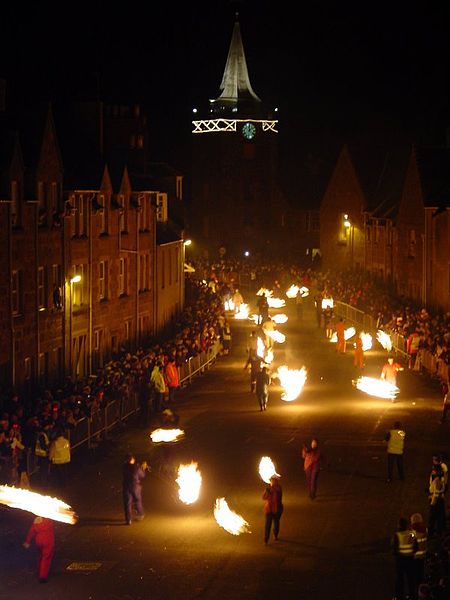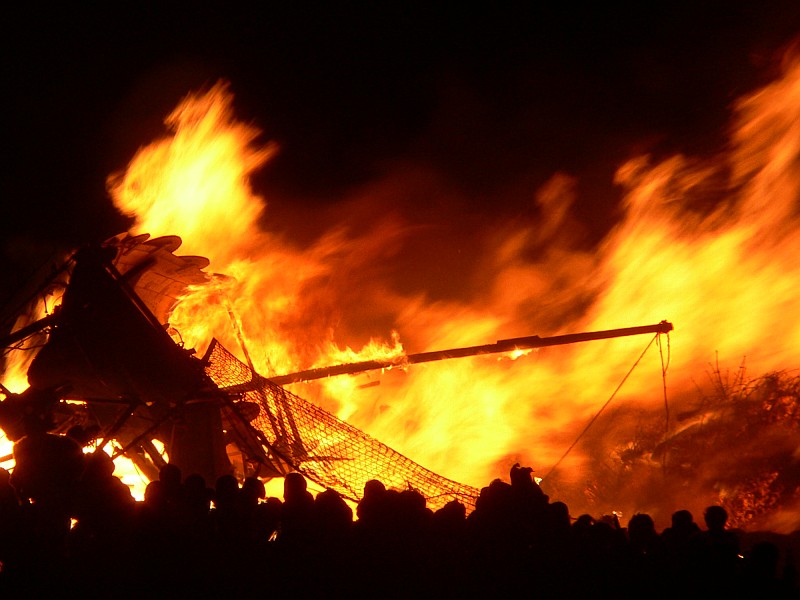I’m thinking that the Scots know how to do New Year’s. Their celebration of Hogmanay may have roots in early Viking celebrations of winter solstice or other pre-Christian winter customs. Or maybe Hogmanay became the popular celebration because celebrating Christmas was forbidden in Scotland for 400 years. Blame the Protestant Reformation for that.
Lots of the celebrations include fire.
Stonewall
 In Stonewall, each New Year’s Eve men parade down the streets swinging huge fireballs over their heads by wire or chains. Any fireballs left burning are flung into the harbor.
In Stonewall, each New Year’s Eve men parade down the streets swinging huge fireballs over their heads by wire or chains. Any fireballs left burning are flung into the harbor.
Burning of the Clavie
Burghead has the Burning of the Clavie, albeit taking place Jan 11.
The clavie is a half-cask is filled with wood shavings and tar that is set on fire. A Clavie king and his helpers parade the burning barrel around town and the charcoal from the fire is collected and placed in fireplaces to ward off evil spirits.
Edinburgh
 A Viking longship is burned in Edinburgh harbor as part of that city’s days long celebration. And Edinburgh has a big fireworks display as well.
A Viking longship is burned in Edinburgh harbor as part of that city’s days long celebration. And Edinburgh has a big fireworks display as well.
Lerwick has an actual fire festival the last Tuesday in January. Paraders carry torches in procession and a galley is burned.
Me, I’m probably going to sit by my own fireplace and bring in the New Year quietly. I like the end of the old year and beginning of the new one to be quiet and peaceful after all the busyness of November and December.
How about you?
Auld Lang Syne
What other way can I wish you a Happy New Year without including Auld Lang Syne. In Scotland, revelers only link hands during the last verse:
And there’s a hand, my trusty fiere !
and gie’s a hand o’ thine !
And we’ll tak a right gude-willy waught,
for auld lang syne.

Last night we enjoyed a Hogmanay celebration with my kids’ Scottish fiddling group. No burning anything, just good music, good food, good company.
Tonight we’re doing our usual tradition, making a meal with several new recipes. Stuffed mushrooms (in honor of the Hobbit), chicken pot pie with puffed pastry (comfort food requested by my youngest) and a chocolate almond meringue for dessert. I need to get back to the kitchen.
Wishing everyone a happy and safe New Year!
Auld Lang Syne always makes me melancholy but I can’t imagine a new year without it. Scotland sounds like a wonderful place to be this time of year, but the home fireside sounds really nice too.
Happy New Year, Riskies!!!
Yum! That food sounds delish! I’m going to Elena’s for New Year’s! Celebrating Hogmanay in Scotland is on my bucket list. It sounds wonderful!
Tonight I will be staying in with my dogs and cats giving my GH entries their final polish!
Happy New Year Riskies!
A trip to Scotland and Ireland is our dream vacation. Sounds like Hogmanay would be a good time to go. Of course it would be hard to stay long enough to attend the Edinburgh Tattoo. Maybe several trips are in order.
We will spend New Year’s Eve as usual. My husband went to bed about 9PM and I will watch the ball drop on TV if I make it that late (I got 30 minutes sleep last night before getting called out for a fire response. I got a couple hours of sleep this afternoon, but it isn’t going to be a late night.)
We have always concentrated more on celebrating New Year’s Day.
I hope you have a wonderful 2013.